Elias Durnford, eldest son of Elias and Martha Durnford. He was born 1739.
Elias Durnford III was a British Army Officer.
His achievements have had an impact on places all over the globe. He was trained in London at the Office of Ordinances.
He jointed the Royal Engineers and was made a Practitioner Engineer with rank of Ensign
on March 17, 1759 and promoted Sub-Engineer and Lieutenant on Jan. 28 1762.

He married Rebecca Walker 25 August 1769
Rebecca was from the parish of Lowestoft in London. She was a minor at the time of the marriage, and had the consent of her father Philip.
The witnesses were Clark and Mary Durnford (his brother)
| First name(s) | ELIAS |
|---|---|
| Last name | DURNFORD |
| Marriage year | 1769 |
| Marriage day | 25 |
| Marriage month | Aug |
| Parish | St James The Less, Thorndike Street |
| Spouse's first name(s) | REBECCA |
| Spouse's last name | WALKER |
| Groom's parish | St James Piccadilly |
| Bride's parish | Lowestoft |
| County | Middlesex |
| Record set | Westminster Marriages |
| Category | Birth, Marriage, Death & Parish Records |
| Record collection | Marriages & divorces |
| Collections from | Great Britain |
Children of ELIAS DURNFORD and REBECCA WALKER :
i. LT. Gen Elias Walker Durnford, b. Jul 28, 1774, Lowestoft, England;
d. Mar 08, 1850, Clarence Villa, Tunbridge Wells, UK. m Jane Sophia Mann
ii. Philip Durnford, b. Mar 31, 1780, Pensacola, West Florida; d. Dec 09, 1829, Jamaica. Unmarried. Military service: Royal Artillery, Lt-Colonel. Spent time in Montivedero
South America and service in Ireland at Charlemont.
iii. Charlotte Durnford, b. Sep 04, 1782, Newcastle-on-Tyne, England;
d. Great Yarmouth, England.
iv. Thomas William Durnford, b. Dec 08, 1784, Tynemouth, Northumberland, England;
d. Jan 31, 1789, Tynemouth, Northumberland, England.
v. Caroline Durnford b. Jul 24, 1787, Lowestoft, England; d. Cheshut, Herts;
m. WILLIAM DAVIS, Mar 15, 1807, Taunton, Somerset.
vi. Lieut Gen. George Durnford b 1788 - 1870 m Eliza Hamilton Earle.
vii Maria Durnford ,b. Dec 02, 1790; d. Aug 05, 1860. Great Yarmouth in Norfolk
viii. Harriett Durnford b. Mar 02, 1794. d 9 Oct 1868 Devonshire
Elias Durnford was also an accomplished artist, and engravings of his sketches from Cuba today sell for thousands of dollars.After the war, Durnford became chief engineer and surveyor general of the new colony of West Florida thanks to the patronage of Lord Harcourt.
In addition to his modest annual salary, Durnford also earned money for every 100 acres he or his assistants surveyed, which greatly enhanced his income, as land grants of thousands of acres were commonplace in West Florida.
Durnford's personal holdings totaled 52,662 acres, the jewel of which was his 5,000-acre plantation, Belle Fontaine, set on the cliffs above Mobile Bay's eastern shore.
Located near present-day Montrose, the area was free from the fevers and crowding that plagued Mobile and was also home to Crofton, a military convalescent hospital.
Unfortunately it was burnt when he had to surrender to the Spanish.
In 1784 he was Commanding Engineer at Newcastle (at the same time his brother Andrew was Chief Engineer at Chatham, with rank of Captain-Lieutenant) and was later appointed the chief Engineer at Plymouth.
At the beginning of 1794 an expedition was sent to attack the French West Indies colonies under General Sir Charles Grey, Durnford (now a Colonel) was appointed to command the Royal Engineers who accompanied the force.
Both he and his son, Elias Walker, a subaltern, were captured by the French.
A few weeks after the capture by the English of Guadeloupe, Elias Durnford died of yellow fever at Tobago on June 21, 1794.
He served for 35 years in the Royal Engineers.
i. LT. Gen Elias Walker Durnford, b. Jul 28, 1774, Lowestoft, England;
d. Mar 08, 1850, Clarence Villa, Tunbridge Wells, UK. m Jane Sophia Mann
ii. Philip Durnford, b. Mar 31, 1780, Pensacola, West Florida; d. Dec 09, 1829, Jamaica. Unmarried. Military service: Royal Artillery, Lt-Colonel. Spent time in Montivedero
South America and service in Ireland at Charlemont.
iii. Charlotte Durnford, b. Sep 04, 1782, Newcastle-on-Tyne, England;
d. Great Yarmouth, England.
iv. Thomas William Durnford, b. Dec 08, 1784, Tynemouth, Northumberland, England;
d. Jan 31, 1789, Tynemouth, Northumberland, England.
v. Caroline Durnford b. Jul 24, 1787, Lowestoft, England; d. Cheshut, Herts;
m. WILLIAM DAVIS, Mar 15, 1807, Taunton, Somerset.
vi. Lieut Gen. George Durnford b 1788 - 1870 m Eliza Hamilton Earle.
vii Maria Durnford ,b. Dec 02, 1790; d. Aug 05, 1860. Great Yarmouth in Norfolk
viii. Harriett Durnford b. Mar 02, 1794. d 9 Oct 1868 Devonshire
Elias Durnford was also an accomplished artist, and engravings of his sketches from Cuba today sell for thousands of dollars.After the war, Durnford became chief engineer and surveyor general of the new colony of West Florida thanks to the patronage of Lord Harcourt.
In addition to his modest annual salary, Durnford also earned money for every 100 acres he or his assistants surveyed, which greatly enhanced his income, as land grants of thousands of acres were commonplace in West Florida.
Durnford's personal holdings totaled 52,662 acres, the jewel of which was his 5,000-acre plantation, Belle Fontaine, set on the cliffs above Mobile Bay's eastern shore.
Located near present-day Montrose, the area was free from the fevers and crowding that plagued Mobile and was also home to Crofton, a military convalescent hospital.
Unfortunately it was burnt when he had to surrender to the Spanish.
In 1784 he was Commanding Engineer at Newcastle (at the same time his brother Andrew was Chief Engineer at Chatham, with rank of Captain-Lieutenant) and was later appointed the chief Engineer at Plymouth.
At the beginning of 1794 an expedition was sent to attack the French West Indies colonies under General Sir Charles Grey, Durnford (now a Colonel) was appointed to command the Royal Engineers who accompanied the force.
Both he and his son, Elias Walker, a subaltern, were captured by the French.
 |
| Tobago |
A few weeks after the capture by the English of Guadeloupe, Elias Durnford died of yellow fever at Tobago on June 21, 1794.
He served for 35 years in the Royal Engineers.
Some of his paintings (a web search will reveal more)!
 |
| View of the Franciscan Church and Convent in the city of Havana, taken from the Mayor's House in Grand Square, ca. 1763 |
 |
| His old maps |
At the time of his death the children were young. 5 of them were under 10, the youngest only 2 months of age.
Elias Durnford
|
|
Dates:
|
1776-1800
|
Title:
|
Major, Esq.
|
Gender:
|
Male
|
society/club
membership:
|
Society of Antiquaries of
London, member, Nov. 25, 1784
|
Source
Date:
|
1784
|
Source
Info:
|
Appears in list of members A
list of the members of the Society of Antiquaries of London, from their
revival in 1717, to June 19, 1796. Arranged in chronological and alphabetical
order. [Bodley Gough Lond.119(5)], 1717-1796. London; Printed by and for John
Nichols, at Cicero's Head, Red Lion Passage, Fleet-street. MDCCXCVIII [1798]
|
Elias Durnford
|
|
Dates:
|
1751-1775
|
Title:
|
Esquire, Lieut. Governor of
West Florida, America
|
Gender:
|
Male
|
Office
Holdings:
|
Military Office(s): Lieut.
Governor of West Florida, America, Appointed in August 1769
|
Source
Date:
|
August, 1769
|
Source
Info:
|
Gentleman's Magazine, August,
1769
|
Their sons also followed a military tradition and were in the Royal Engineers
ELIAS WALKER DURNFORD; army officer and military engineer; b. 28 July 1774 in Lowestoft, England, son of Elias Durnford and Rebecca Walker; d. 8 March 1850 in Tunbridge Wells (Royal Tunbridge Wells), England.
Although he was born in Suffolk, on the North Sea coast, Elias Walker Durnford spent his first years in Pensacola (Fla), where his father was commanding engineer and then lieutenant governor of the British colony of West Florida.
When he was about four, he went back to England without his parents, who entrusted him to the care of an aunt Elizabeth Fontenelle, Rebecca's sister.
After his father also returned on the conclusion of the American revolution, Elias, who wanted to become a military engineer himself, attended a preparatory school for the Royal Military Academy in Woolwich (London) and was subsequently admitted to the academy in October 1788.
He was commissioned in the Royal Artillery in April 1793, at 18 years of age, and in October was promoted second lieutenant in the Royal Engineers. His first posting took him to the West Indies to serve alongside his father. In 1794 he directed the construction of defensive works for Pointe-à-Pitre in Guadeloupe, where he was subsequently taken prisoner by the French.
After 17 months of captivity he was exchanged in July 1796 for a French officer. He resumed his engineering duties in England, and then in Ireland. When he was appointed in 1808 as commanding engineer in Newfoundland, he had to give up a “deep desire” to take part in the war in Spain.
In Newfoundland Durnford was primarily occupied with maintaining and building coastal batteries; he also put up a blockhouse on Signal Hill, near St John’s. In 1813 he became a major in the army and a lieutenant-colonel in the Royal Engineers, undertaking garrison duties in addition to his engineering responsibilities. He was also named aide-de-camp to the officer commanding the forces on the island.
During his stay he obtained a grant of four acres on which he grew potatoes.
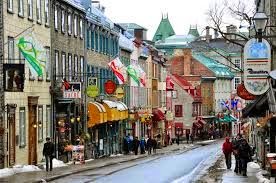 From 1816 to 1831 Durnford was commanding officer of the Royal Engineers in the Canadas. He lived at first in a rebuilt section of the former intendant’s palace at Quebec, and then moved with his family into the official residence for the commander of the Royal Engineers on Rue Saint-Louis.
From 1816 to 1831 Durnford was commanding officer of the Royal Engineers in the Canadas. He lived at first in a rebuilt section of the former intendant’s palace at Quebec, and then moved with his family into the official residence for the commander of the Royal Engineers on Rue Saint-Louis.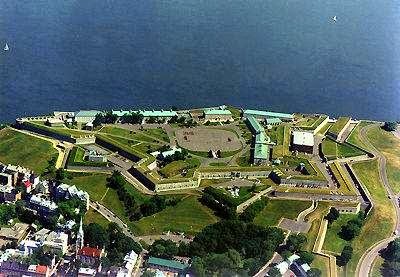 The construction of the Quebec citadel was undoubtedly his major accomplishment in British North America. The work substantially completed the town’s defensive system, but the classical plan he had chosen showed that the military had a constant fear of a popular uprising.
The construction of the Quebec citadel was undoubtedly his major accomplishment in British North America. The work substantially completed the town’s defensive system, but the classical plan he had chosen showed that the military had a constant fear of a popular uprising.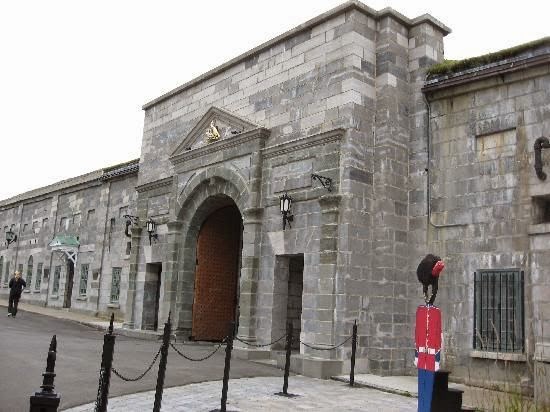 At Quebec Durnford also was in charge of rebuilding the Palais gate as well as of repairing the Anglican Cathedral of the Holy Trinity. He coordinated the reorganization of the colonies’ defences to fit a new plan developed after the War of 1812 by the governor, the Duke of Richmond [Lennox*], and approved by the Duke of Wellington.
At Quebec Durnford also was in charge of rebuilding the Palais gate as well as of repairing the Anglican Cathedral of the Holy Trinity. He coordinated the reorganization of the colonies’ defences to fit a new plan developed after the War of 1812 by the governor, the Duke of Richmond [Lennox*], and approved by the Duke of Wellington.
A number of military works were built at that time, on Île Sainte-Hélène and Île aux Noix and at Kingston, Upper Canada, among other places. In addition, Durnford worked on the construction of canal systems on the Rideau and Ottawa rivers, although the Rideau Canal was built under his friend John By in the period 1826–31 and was never under his authority.
In 1823 he had signed a voluminous report on the state of the fortifications and military buildings in the Canadas. He obtained the rank of colonel in the Royal Engineers in March 1825. As such he was granted his request, made to Governor Lord Dalhousie [Ramsay], that he be appointed commander of the troops in Lower Canada while retaining his engineering post; to his chagrin, he had failed to obtain the command a few months earlier.
Durnford returned to England in 1831 and six years later was retired from service. In 1846 he obtained the supreme rank of colonel commandant in the engineers, and in the army he almost reached the top, since he was made a lieutenant-general.
Throughout his career Durnford displayed assiduity and exemplary honesty, and he apparently won the esteem of both colleagues and superiors. During the height of the construction season he visited work sites early in the morning and then busied himself in the engineers’ office until supper time, late in the evening.
Eager to manage public funds with economy, he behaved irreproachably in the numerous transactions that he conducted in the name of the British government to purchase properties needed for the glacis of the Quebec citadel. Despite his zeal, he was not always beyond reproach.
In 1825 the Board of Ordnance accused him of being lax in his administration of the Royal Engineers, in particular because of appointments and salary arrangements made without following the usual administrative procedures. Like most military engineers of the time Durnford did a poor job of calculating the building costs for military works.
The case of the citadel is especially revealing: initially estimated at £72,400, the project cost the Treasury a little more than twice this sum.
Family values, along with professional principles, were of the greatest importance for Durnford.
On 30 Oct. 1798 he married Jane Sophia Mann, daughter of a lawyer in Gravesend, England. They had 13 children, of whom four were born in Newfoundland and three at Quebec.
Their six sons followed in Durnford’s footsteps to become officers in the British army. Three worked in turn with him as clerks in the office of the Royal Engineers at Quebec, and the eldest and the youngest joined the corps. The family followed him wherever he went, and two of his unmarried daughters remained with him even after he retired.
An ardent conservative, Durnford respected the traditional values of his station, although he did not much enjoy social gatherings. He engaged in several sports, including cricket. Whether in Newfoundland, the Canadas, or Tunbridge Wells, the village to which he retired, Durnford liked to relax by gardening and taking care of a few animals.
He was fond of reading, as was his wife; he particularly enjoyed Hannah More’s religious and philanthropical works, which he bought for the Garrison Library at Quebec when he was its president.
It is difficult to estimate Durnford’s fortune. Certainly, his engineering officer’s pay, his post as officer commanding the Royal Engineers, and the various allowances to which he was entitled put him near the top of the British army’s pay structure.
He regularly kept more than one servant, and sometimes three or four. His sons studied at private institutions in England, and he gave them allowances befitting their rank. Durnford also travelled a great deal.
His father and one of his aunts had owned numerous lands in Florida and New Orleans which were confiscated as a result of the American revolution. He took various measures, even making a six-month trip to the United States in 1820 and going to court several times in 1838, but title had been lost and he was never able to profit from these holdings. It is not known whether he received money that had been left by his father for his mother’s use, but when her second husband died, he inherited £1,000 sterling.
Elias Walker Durnford’s career was centred mainly on administration and no important scientific contribution to military engineering came out it.
The name Durnford remained famous in the Royal Engineers, however, through the ongoing presence for more than a century and a half of 11 members of the family. In addition to his father and two of his own sons, his brother Andrew and four of Andrew’s descendants, as well as two other Durnfords whose relationship is not known, all served in the corps.
Through the descendants of a third son, Philip, the Durnford line still exists in Canada today.
Elias Walker Durnford began writing his autobiography but it was never finished. The first part was published in 1850, the year in which he died, as “Scenes in an officer’s early life at Martinique, Guadeloupe, &c., during the years 1794 & 1795, recalled in advanced years,” Colburn’s United Service Magazine (London), pt.ii: 605–14.
 Durnford was born in 1774 in Lowestoft, Suffolk. He was commissioned as a Second Lieutenant in the Corps of Royal Engineers
on 24 April 1793. Durnford married Jane Sophia Mann on 30 October 1798.
On 10 January 1837 he removed from the Corps, on being promoted to the
rank of Major General. Major General Elias Walker Durnford R.E. died in 1850 in Clarence Villa, Tunbridge Wells, Kent, at the age of 75.
Durnford was born in 1774 in Lowestoft, Suffolk. He was commissioned as a Second Lieutenant in the Corps of Royal Engineers
on 24 April 1793. Durnford married Jane Sophia Mann on 30 October 1798.
On 10 January 1837 he removed from the Corps, on being promoted to the
rank of Major General. Major General Elias Walker Durnford R.E. died in 1850 in Clarence Villa, Tunbridge Wells, Kent, at the age of 75.
There is a good chance that this was where the Clarence Villa's were, as it was reported in the newspapers when he died, that he enjoyed the garden.
His daughter Mary wrote a book about him: Family recollections of Lieut. General Elias Walker Durnford. It was printed in 1863. Publication: Montreal, Printed by J. Lovell.
He and Jane
had 11 children, 5 daughters and 6 sons among those:
·
Philip Durnford Captain of the 68th Regiment Later a Collector of
Inland Revenue Montreal
He married Augusta Sewell. Daughter of the Solicitor General for Lower Canada,
and they had 5 Children The family lived in Canada, where he died 1881 in
Montreal Canada
·
George Durnford Born 1838 d 1922
Chartered Accountant, manager of Bank of British North America in
Ontario. Married Melanie Vardon, daughter
of Assist. Supt of Indian Affairs. Lived in Montreal
·
Charles Durnford Member of the 65th Regiment - Ensign Charles - 65th Foot - died
7th January 1832 . Memorial Royal
Garrison Church, Portsmouth - "In memory of Charles Durnford late Ensign
of His Majesty's 65th Regt and fifth son of Colonel Durnford of the Corps of
Royal Engineers who died at this place on the 7th of January 1832 aged 20
yrs."
Third
Generation of Durnford's to serve at Royal Engineers
Elias Durnford 2nd Lieutenant RE He died 1835 on the way to Ceylon
·
John Durnford b 1809
d 1891 Worked in Royal Engineers. Married Charlotte Sewell
·
Viney Durnford 2nd Lieut Royal Engineers Died 5th November 1836
Their six sons followed in
Durnford’s footsteps to become officers in the British army. Three worked in
turn with him as clerks in the office of the Royal Engineers at Quebec, and the
eldest and the youngest joined the corps. The family followed him wherever he
went, and two of his unmarried daughters remained with him even after he
retired."
MEMORIAL TABLETS IN HONOUR OF TWO OF THE
"MILITARY DURNFORDS"
In the Royal Garrison Church, Portsmouth, South Isle, West End
In the Royal Garrison Church, Portsmouth, South Isle, West End
In
memory of
CHARLES DURNFORD
Late Ensign in His Majesty's 65th Regiment
and fifth son of Colonel Durnford of the Corps of Royal Engineers,
Who died at this place on the 7th of January, 1832
Aged 20 years.
CHARLES DURNFORD
Late Ensign in His Majesty's 65th Regiment
and fifth son of Colonel Durnford of the Corps of Royal Engineers,
Who died at this place on the 7th of January, 1832
Aged 20 years.
In
the churchyard of St. Mary's, Portsea (formerly the Parish Church, Kingston)
is a tombstone with the following inscription:
is a tombstone with the following inscription:
In
memory of
CHARLES DURNFORD
Late Ensign in His Majesty's 65th Regiment
and fifth son of Colonel Durnford of the Corps of Royal Engineers,
Who died at this place on the 7th of January, 1832
Aged 20 years.
And of his brother
VINEY DURNFORD
Lieutenant of the Corps of Royal Engineers,
Who died on the 5th of November 1836,
Aged 23 years.
CHARLES DURNFORD
Late Ensign in His Majesty's 65th Regiment
and fifth son of Colonel Durnford of the Corps of Royal Engineers,
Who died at this place on the 7th of January, 1832
Aged 20 years.
And of his brother
VINEY DURNFORD
Lieutenant of the Corps of Royal Engineers,
Who died on the 5th of November 1836,
Aged 23 years.
(Note:
The above were sons of Elias Walker Durnford)
Philip Durnford
Was in the 68th Regiment
Anglo-Allied Army in Flanders and France 1815
Unattached Artillery Companies:
Garrison Troops: Napoleon series
Arentschild's Company, KGL [2nd Coy] (1st LT. Augustus Pfannkuche
Arentschild's Company, KGL [2nd Coy] (1st LT. Augustus Pfannkuche
Jones's Company [1st Bn.] (Captain [Brevet Major] Richard Jones)
He also spent time at Montevideo Uruguay South America. A very old town, with magnificent buildings and architecture. The town is walking distance from the dock.
 |
| It's probably changed in 200 years! |
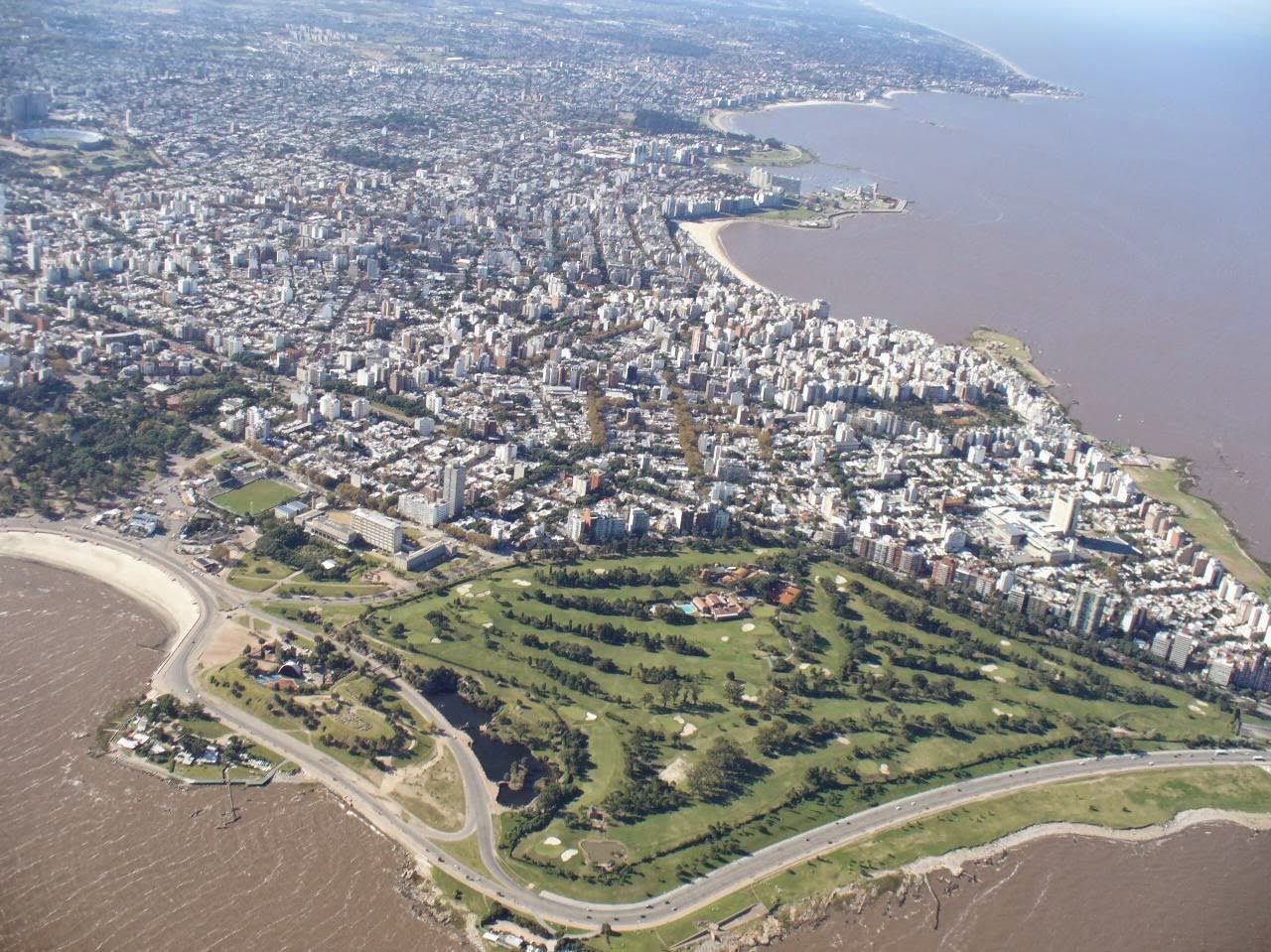
Durnford - Ensign Charles - 65th Foot - died 7th January 1832.
Memorial Royal Garrison Church, Portsmouth - "In memory of Charles Durnford late Ensign of His Majesty's 65th Regt and fifth son of Colonel Durnford of the Corps of Royal Engineers who died at this place on the 7th of January 1832 aged 20 yrs."
George Durnford
·
George Durnford b 4 June 1807 Clonmell
Ireland, died 21 January 1879 Col in
70th Regt
m
Henrietta Elizabeth de Courcy b
1816 Guernesy d 1900
The Sutlej Medal was
a campaign medal approved in 1846, for issue to officers and men of the British
Army and Honourable East India Company who served in the Sutlej campaign of
1845-46 (also known as the First Anglo-Sikh War). This medal was the first to
use clasps to denote soldiers who fought in the major battles of the campaign.
The medal was
approved on 17 April 1846
First
Name:
|
George
|
||||
Initials:
|
G
|
||||
Surname:
|
Durnford
|
||||
Nationality:
|
British
|
||||
Rank:
|
Major
|
||||
Rank
(2nd):
|
Acting Lieutenant Colonel
|
||||
Campaign
Medals:
|
Indian Mutiny Medal
The Indian Mutiny Medal of George Durnford was a campaign medal issued to British and Indian units who served in operations against the Indian mutineers of 1857-58. Five clasps were authorised alongside the medal indicating service in a particular campaign or battle, though the medal could be issued without a clasp to those who served but were not eligible for a clasp. Buy Medals |
||||
Clasps
Awarded:
|
Medal
Only
|
The Indian Mutiny Medal was a campaign medal approved in 1858, for issue to officers and men of British and Indian units who served in operations in suppression of the Indian Mutiny.
The medal was
initially sanctioned for award to those troops who had been engaged in action
against the mutineers.
However in 1868 the award was extended to all those who had borne arms or who had been under fire, including such people as members of the Indian judiciary and the Indian civil service, who were caught up in the fighting. Some 290,000 medals were awarded.
The obverse of the medal depicts the head of a young Queen Victoria and bears the inscription Victoria Regina. The reverse shows a helmeted Britannia holding a wreath in her right hand and a union shield on her left arm. She is standing in front of a lion. The words "India 1857-1858" are inscribed on the reverse of the medal. The ribbon is white with two scarlet stripes.
Five clasps were
authorised, though the maximum awarded to any one man was four. The medal was issued
without a clasp to those who served but were not eligible for a clasp. The vast
majority of these awards were made to those who became entitled to the medal as
a result of the 1868 extensions of eligibility.
What a huge number of soldiers involved in the Battles in India.
***********************************************************************************
Rebecca remarried Col John Sheldrake in October 1796. She died when he was serving in Armagh in Ireland in 1810.
Colonel John Sheldake
Colonel in Royal Artillery
He was first appointed Second Lieut in the Royal Artillery
in 1780 then he rose in rank to Colonel on 20 December 1815. He served seven years at Gilbraltar,
commencing at the siege, ten years in the West Indies, in Demerara, Esseqibo
and Berbice. In 1803 he was posted to
Ireland commanding the Royal Artillery, except for some time in Corunna.
From Rebecca's granddaughter Mary's recollections:
Col. John Sheldrake was a meritorious officer: he was 50 years old before
attaining the rank of Captain; from which point, however, his promotion was
quick. He owned a valuable sugar plantation at Demerara, the management of
which and anxiety about, seems to have been his care and perplexity through
life, from the want of ready money to work it advantageously.
Mrs. Sheldrake
fulfilled her duty as a mother to the seven children of her former husband, by
refusing to lend any of the small fortune remaining to them, to aid in
cultivating this estate.

Demerara. In 1823, there was an uprising when 10,000 slaves rioted
During the period of detention at Portsmouth, Col. Sheldrake came to that
post, " en route " to join the British army at Corunna. Mrs.
Sheldrake and her daughter, Maria Durnford, spent the winter there; thus
affording the mother another meeting with her son, who was still at Portsmouth,
when Col. Sheldrake returned.
The colonel had commanded a division of artillery
at the battle of Corunna, and came back with the wreck of Sir John Moore's army
which was landed at " the Hard ;" and for days succeeding its
disembarkation, the landing places and streets were strewed with languid
spectres, lying pallid and attenuated, "hard at death's door."
 |
| Demerara. In 1823, there was an uprising when 10,000 slaves rioted |
Speaking of her father, Elias, Mary continues:
In the Christmas of 1808, while paying a visit to his mother, now become the wife
of Lieut.-Col. John Sheldrake, of the Royal Artillery, at Island Bridge, near Dublin,
he met his brothers, Capt. Philip and Lieut.George Durnford, both holding commissions in
the same corps with their stepfather ; and for a few weeks they enjoyed the society of each
other.
He died at his home Thenhurst Cottage in Berkshire in 1820. In his will, whch might have been the subject to disputes, he left a legacy to his mulato slave in Demarara.



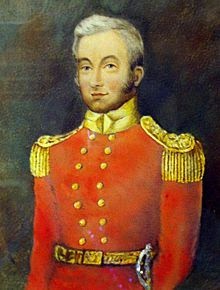



No comments:
Post a Comment